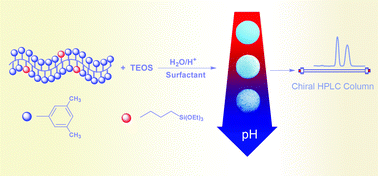Preparation of porous cellulose 3,5-dimethylphenylcarbamate hybrid organosilica particles for chromatographic applications†
Abstract
Organic–inorganic hybrids incorporating cellulose tris(3,5-dimethylphenylcarbamate) (CDMPC)-functionalized silica particles can exhibit a high loading capacity with high loadings of the chiral selector. These materials offer considerable potential for use in preparative chiral separations. However, the preparation of these hybrid particles with high surface areas and controlled organic/inorganic ratios is challenging. We have found that by controlling the pH of sol–gel step and regulating the ratio of the inorganic precursor over CDMPC, unique functional hybrid particles could be prepared with optimum pore structure, novel interfacial features and excellent mechanical strength. The morphological features of these hybrid particles were characterized by scanning electron microscopy (SEM) and transmission electron microscopy (TEM). The organic content was determined by thermogravimetric analysis (TGA) and pore structure determined by Brunauer–Emmett–Teller (BET) analysis. These new hybrid particles exhibit excellent solvent durability, which is crucial for preparative chromatography. HPLC analysis of columns, packed with this material, confirmed solvent tolerance such as for chloroform, giving potential applications for large scale chromatographic separations.


 Please wait while we load your content...
Please wait while we load your content...